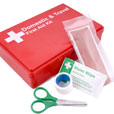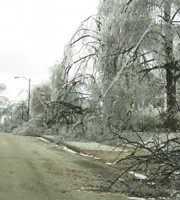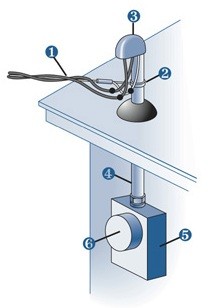Be Prepared For Storms
Severe weather can strike quickly, and sometimes, without warning. Keep track of power outages and learn more about how to prepare for severe weather.
 Storm Outage Maps
Storm Outage Maps
Ameren Missouri
Evergy Missouri Metro / Evergy Missouri West (formerly Kansas City Power & Light / KCP&L-Great Missouri Operations)
The Empire District Electric Company (d/b/a Liberty Utilities)
Association of Missouri Electric Cooperatives
Preparing For Potential Outages
Put together an emergency kit with items that will be useful in other situations as well. Store these items in a water-tight container. Items can include:
- Bottled water (Most emergency preparedness experts recommend having a three-day supply on hand.)
- Ready-to-eat foods
- A manual can opener
- Battery-operated radio, clock, flashlights and extra batteries
- Blankets
- First aid kit
Keep Food Safe
Keep your refrigerator and freezer doors closed as much as possible to maintain the cold temperature. A full freezer should keep food frozen and safe for about two days when kept closed. Make sure you have items on hand that do not require refrigeration and can be eaten cold or heated outside on an outdoor grill. To learn more about keeping food safe during a power outage, visit FoodSafety.gov.
Temporary Heating or Cooking Sources (Beware of Dangerous Fumes)
- Do not use kerosene or propane heaters inside without proper ventilation
- Do not burn charcoal in your house or garage
Using Space Heaters
Use space heaters only as a supplementary source of heat. These devices are not intended to replace the home's heating system.
- Never leave space heaters unattended; turn heaters off when you go to bed or leave the room.
- Place the heater on a level floor surface away from foot traffic. Be especially careful to keep children and pets away from the heater.
- Keep all space heaters at least 3 feet away from household combustibles like fuel, spray cans, paint, drapes, sofas and blankets.
- Plug portable heaters directly into outlets.
- Do not overload circuits. Make sure the unit is not plugged into the same circuit as other electric appliances.
- Check to make sure the heater is clean and in good condition.
- Replace older models with newer, safer models that carry the Underwriter's Laboratory (UL) label.
- Always check and follow any manufacturer's instructions pertaining to the use of an extension cord.
Protecting Appliances
Turn off lights and unplug as many appliances and electronics as possible. Surges or spikes when power is restored could damage sensitive equipment such as computers, microwave ovens, televisions and recording devices. Adjust thermostats to prevent furnaces or air conditioners from immediately trying to start up once power is restored. Wait 15 minutes before resetting thermostats to their normal settings to reduce the demand on the system while the utility is restoring service.
Downed Power Lines
- Call 911 immediately. If you see a downed power line, don't touch it!
- Be extra cautious when you go outside to inspect for damage after a storm. Downed or hanging electrical wires can be hidden by trees or debris, and could be live. Never attempt to touch or move downed lines, and keep children and pets away from them.
- Do not touch anything power lines are touching, such as tree branches or fences. Always assume a downed line is a "live line."
Generator Safety Tips
The Weatherhead -- Who Is Responsible?
 Most electric utilities do not own the weatherhead (the pipe that is above your meter and is typically attached to the side of your house or extends above your roof). If the weatherhead has been damaged, it may be unsafe.*
Most electric utilities do not own the weatherhead (the pipe that is above your meter and is typically attached to the side of your house or extends above your roof). If the weatherhead has been damaged, it may be unsafe.*
*Only a qualified electrician should ever attempt to work on these weatherhead components.
The utility company cannot restore your electric service until the damage is repaired.
Your utility provider will install and maintain these components:
(1) The “service drop” that carries power from the line to a home or business.
(6) The electric meter.
Homeowners are responsible for these components*:
(2) The service bracket or pipe which protects the connection point for the lines that enter your home or business.
(3) The “weatherhead” that keeps rain and material out of the pipe.
(4) The pipe riser that protects the line entering the meter.
(5) The meter box or base that protects all connections to the meter.
*Only a qualified electrician should ever attempt to work on these weatherhead components.
 Missouri Public Service Commission
Missouri Public Service Commission